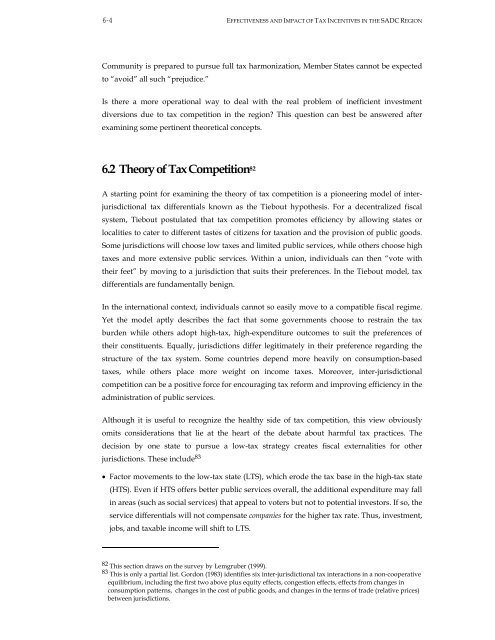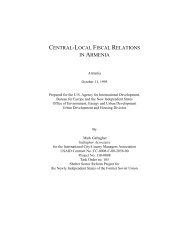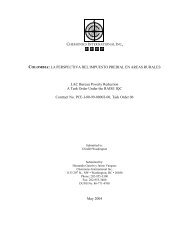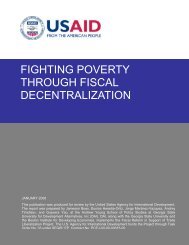Effectiveness and Economic Impact of Tax Incentives in the SADC ...
Effectiveness and Economic Impact of Tax Incentives in the SADC ...
Effectiveness and Economic Impact of Tax Incentives in the SADC ...
You also want an ePaper? Increase the reach of your titles
YUMPU automatically turns print PDFs into web optimized ePapers that Google loves.
6-4 EFFECTIVENESS AND IMPACT OF TAX INCENTIVES IN THE <strong>SADC</strong> REGION<br />
Community is prepared to pursue full tax harmonization, Member States cannot be expected<br />
to “avoid” all such “prejudice.”<br />
Is <strong>the</strong>re a more operational way to deal with <strong>the</strong> real problem <strong>of</strong> <strong>in</strong>efficient <strong>in</strong>vestment<br />
diversions due to tax competition <strong>in</strong> <strong>the</strong> region? This question can best be answered after<br />
exam<strong>in</strong><strong>in</strong>g some pert<strong>in</strong>ent <strong>the</strong>oretical concepts.<br />
6.2 Theory <strong>of</strong> <strong>Tax</strong> Competition 82<br />
A start<strong>in</strong>g po<strong>in</strong>t for exam<strong>in</strong><strong>in</strong>g <strong>the</strong> <strong>the</strong>ory <strong>of</strong> tax competition is a pioneer<strong>in</strong>g model <strong>of</strong> <strong>in</strong>ter-<br />
jurisdictional tax differentials known as <strong>the</strong> Tiebout hypo<strong>the</strong>sis. For a decentralized fiscal<br />
system, Tiebout postulated that tax competition promotes efficiency by allow<strong>in</strong>g states or<br />
localities to cater to different tastes <strong>of</strong> citizens for taxation <strong>and</strong> <strong>the</strong> provision <strong>of</strong> public goods.<br />
Some jurisdictions will choose low taxes <strong>and</strong> limited public services, while o<strong>the</strong>rs choose high<br />
taxes <strong>and</strong> more extensive public services. With<strong>in</strong> a union, <strong>in</strong>dividuals can <strong>the</strong>n “vote with<br />
<strong>the</strong>ir feet” by mov<strong>in</strong>g to a jurisdiction that suits <strong>the</strong>ir preferences. In <strong>the</strong> Tiebout model, tax<br />
differentials are fundamentally benign.<br />
In <strong>the</strong> <strong>in</strong>ternational context, <strong>in</strong>dividuals cannot so easily move to a compatible fiscal regime.<br />
Yet <strong>the</strong> model aptly describes <strong>the</strong> fact that some governments choose to restra<strong>in</strong> <strong>the</strong> tax<br />
burden while o<strong>the</strong>rs adopt high-tax, high-expenditure outcomes to suit <strong>the</strong> preferences <strong>of</strong><br />
<strong>the</strong>ir constituents. Equally, jurisdictions differ legitimately <strong>in</strong> <strong>the</strong>ir preference regard<strong>in</strong>g <strong>the</strong><br />
structure <strong>of</strong> <strong>the</strong> tax system. Some countries depend more heavily on consumption-based<br />
taxes, while o<strong>the</strong>rs place more weight on <strong>in</strong>come taxes. Moreover, <strong>in</strong>ter-jurisdictional<br />
competition can be a positive force for encourag<strong>in</strong>g tax reform <strong>and</strong> improv<strong>in</strong>g efficiency <strong>in</strong> <strong>the</strong><br />
adm<strong>in</strong>istration <strong>of</strong> public services.<br />
Although it is useful to recognize <strong>the</strong> healthy side <strong>of</strong> tax competition, this view obviously<br />
omits considerations that lie at <strong>the</strong> heart <strong>of</strong> <strong>the</strong> debate about harmful tax practices. The<br />
decision by one state to pursue a low-tax strategy creates fiscal externalities for o<strong>the</strong>r<br />
jurisdictions. These <strong>in</strong>clude 83<br />
•<br />
Factor movements to <strong>the</strong> low-tax state (LTS), which erode <strong>the</strong> tax base <strong>in</strong> <strong>the</strong> high-tax state<br />
(HTS). Even if HTS <strong>of</strong>fers better public services overall, <strong>the</strong> additional expenditure may fall<br />
<strong>in</strong> areas (such as social services) that appeal to voters but not to potential <strong>in</strong>vestors. If so, <strong>the</strong><br />
service differentials will not compensate companies for <strong>the</strong> higher tax rate. Thus, <strong>in</strong>vestment,<br />
jobs, <strong>and</strong> taxable <strong>in</strong>come will shift to LTS.<br />
82 This section draws on <strong>the</strong> survey by Lemgruber (1999).<br />
83 This is only a partial list. Gordon (1983) identifies six <strong>in</strong>ter-jurisdictional tax <strong>in</strong>teractions <strong>in</strong> a non-cooperative<br />
equilibrium, <strong>in</strong>clud<strong>in</strong>g <strong>the</strong> first two above plus equity effects, congestion effects, effects from changes <strong>in</strong><br />
consumption patterns, changes <strong>in</strong> <strong>the</strong> cost <strong>of</strong> public goods, <strong>and</strong> changes <strong>in</strong> <strong>the</strong> terms <strong>of</strong> trade (relative prices)<br />
between jurisdictions.











